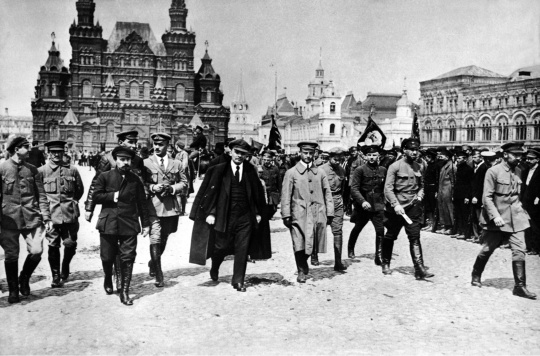Conquer It
Thus far, you have learned about some of the political and economic conditions that caused the Russian Revolution. Next, you will read about the problems that Lenin and the Bolsheviks faced following the revolution. As you read the passage, think about the meaning of the underlined words. Once you have finished reading the passage, complete the assessment activity that follows. Remember, you can always go back and reread the passage in order to increase your understanding.
Read the following paragraph and answer the questions below.

This image shows the Soviet revolutionary leader Lenin with a group of commanders in the Red Square on May 25, 1919. Image credit: Smirnov_N via Wikimedia CommonsOpens a new window
Once the Bolsheviks seized power, Lenin set about tackling the problems he inherited from czarist rule. Within days, Lenin ordered all farmland to be distributed among the peasants. He gave the workers control of the factories. The Bolshevik government also signed a peace treaty with Germany, withdrawing from WWI. The peace treaty humiliated Russia and cost them a great deal of land. People who opposed the Bolshevik actions formed the White Army and tried to retake control of the government. For three years, civil war raged in Russia. Several western nations, including the United States, sent military aid to the White Army. Fifteen million Russians died in the civil war and the famine that followed. The destruction and loss of life from the war, hunger, and a worldwide flu epidemic left Russia in chaos. In the end, the Red Army triumphed and crushed all opposition to Bolshevik rule. The Bolsheviks were able to both seize and maintain power. However, the Bolsheviks faced many problems. The Russian economy had been destroyed.
Lenin set aside his goal of a government controlled economy and turned his attention to restoring the economy with small-scale capitalism. He launched his “New Economic Policy” allowing peasants to sell their surplus crops and individuals were allowed to buy and sell goods for profit. Small factories, businesses, and farms operated under private ownership.
To create national unity, Lenin organized Russia into several self-governing republics under a central government and the capital was moved to Moscow. Russia was renamed the Union of Soviet Socialist Republics or the U.S.S.R. The Bolsheviks renamed their political party the Communist Party. The name came from the writings of Karl Marx. A new constitution was written embracing socialist and democratic ideals. However, the reality was the Communist Party held all political power with Lenin as the dictator of Russia.


